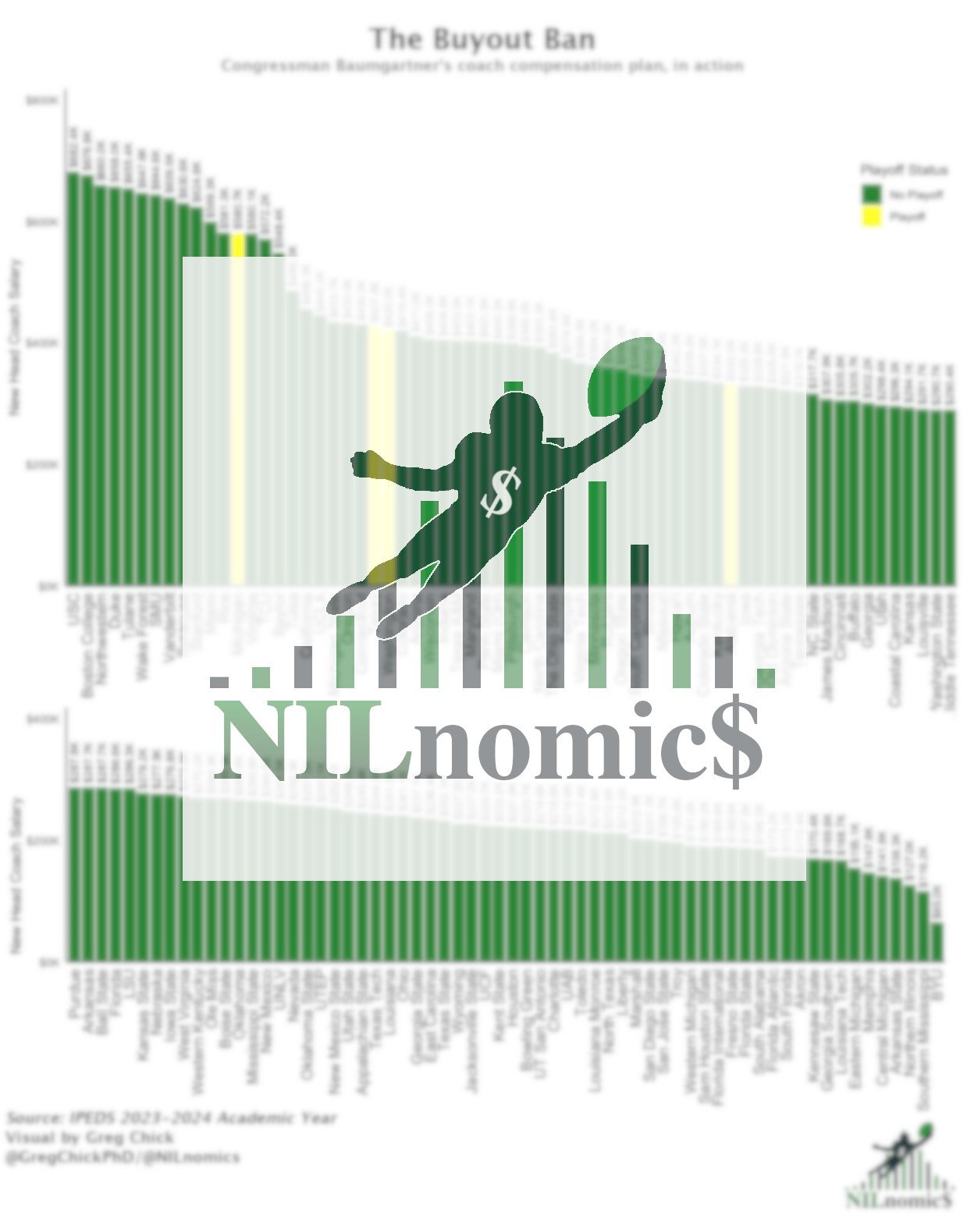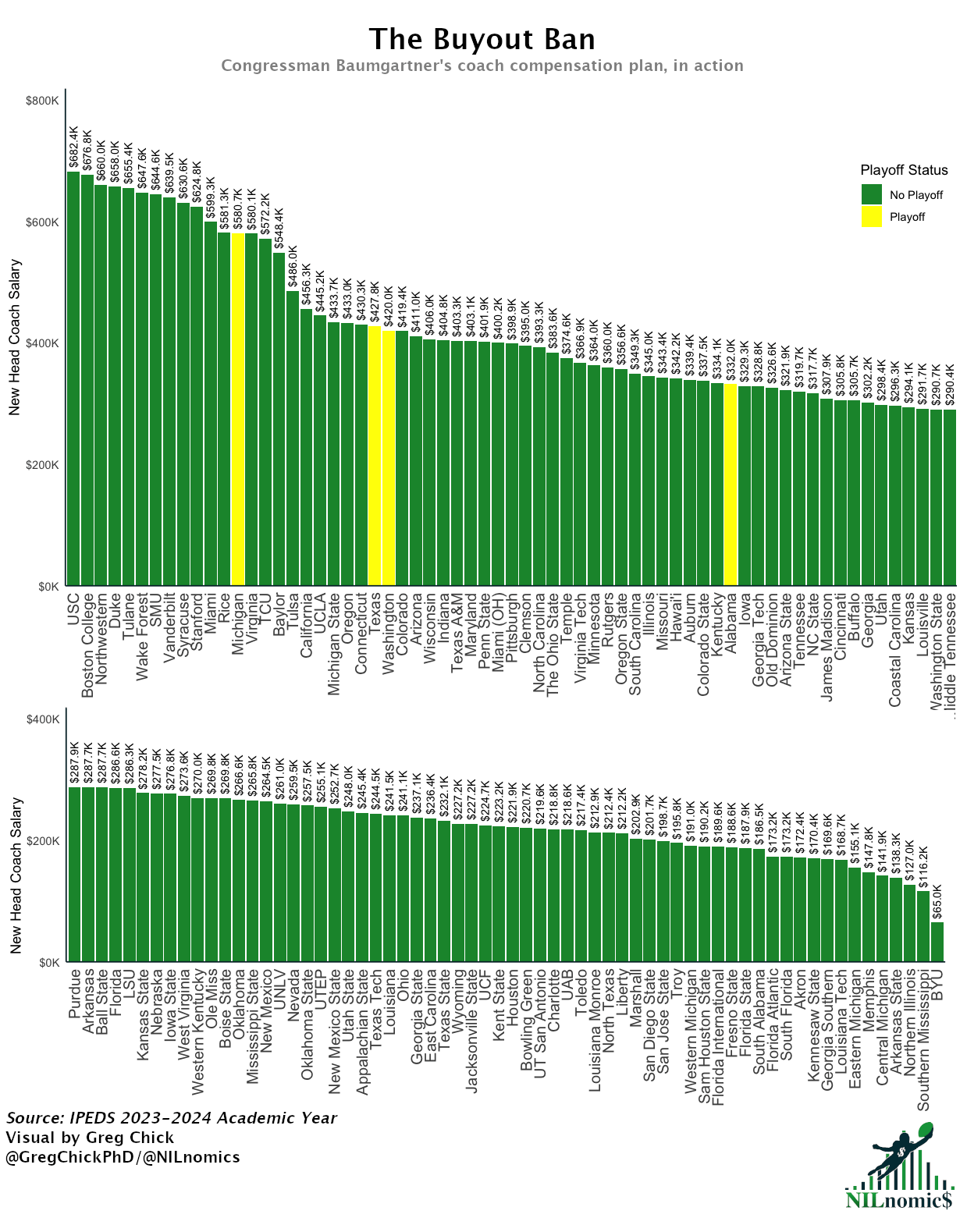- NILnomics
- Posts
- A Crazy Solution to Coach Buyouts
A Crazy Solution to Coach Buyouts
Congress throws out a wild idea, and I'm here to provide the data

Hey there, thanks for spending some time with NILnomics today. I really appreciate it.
Earlier this week I saw Washington Congressman Baumgartner throw out a wild idea. Then I saw nobody else follow up with, to me, the next logical step. So I went through with it
Coach Salary Cap - what do coaches get paid in a salary cap world?
High value coach - if we take coach’s new salaries and compare to their performance, whose the value pick?
Pour a drink. Get comfortable. Let’s get into it.
If you’re not subscribed already, please click subscribe below to get NILnomics in your mailbox each and every week - it’s free!
More than one way to solve a problem
The college football coaching carousel isn’t just spinning — it’s shaking the bolts loose. This season alone, we’ve seen an avalanche of firings: Penn State, Florida, LSU, Auburn, Arkansas, UCLA, Oklahoma State — and that’s not even the full list.
Behind every pink slip lies something even more jaw-dropping: the buyouts.
Brian Kelly’s $54 million.
James Franklin’s $49 million.
Billy Napier’s $21 million.
College football has become a place where schools are paying tens of millions of dollars for coaches not to coach.
It’s no wonder this level of excess has caught the attention of lawmakers. Enter Congressman Michael Baumgartner of Washington, who recently proposed something that would upend the entire system: cap a coach’s salary at 10 times the tuition and fees of their university.
College sports is not the free market. Colleges are highly subsidized public goods.
Great US military generals make $225,000/yr
Great Supreme Court Judged make $300,000/yr
Great HS Coaches (who also teach) make $100,000 - $150,000/yr
Why do bad college coaches get $10m/yr?
— Congressman Michael Baumgartner (@RepBaumgartner)
3:45 PM • Oct 28, 2025
It’s a radical idea — and maybe a timely one. With players now sharing up to 50% of game-related (“pool”) revenue, the old model where coaches command an ever-growing slice of the pie is starting to look unsustainable. The call for balance in college sports economics isn’t just coming from fans anymore — it’s making its way into policy.
But what would that world actually look like?
How much would Nick Saban, Brian Kelly, or James Franklin earn if their paychecks were tied to tuition instead of TV deals?
And which school would suddenly become the most lucrative destination for a head coach?
That’s where I come in. I’ve pulled tuition and fee data across all FBS schools and calculated what coach salaries would look like under Baumgartner’s cap proposal — and the results might surprise you.
Let’s dive in.

Quick Takeaways:
That many private schools shoot to the top of the maximum coach salary isn’t very surprising. But seeing how many of them there are is striking.
I specifically called out/colored the teams that made the College Football Playoff that year (23-24). I think it does a good job showing just what a shift this type of policy could be.
All my coworkers with Boston College ties are going to be elated when they see this. Although to be fair, they have a pretty good coach right now.
The first public university doesn’t show up on the chart until all the way at #13 (Michigan). Coincidentally, that’s the first team on the chart that made the College Football playoffs that year.
Shoutout to BYU, who was the only school I actually confirmed the data for as it blew my mind how low the tuition is there. What a steal.
Analyst’s Desk
Data for this chart comes from IPEDS and is the latest academic year available (2023-2024). Tuition figures are the out-of-state tuition and fees amount for each school.
The cost to win in a new era
The next chart takes those salaries from the Congressman’s proposal and looks at how coaches performed. Who’s getting a deal?

Quick Takeaways:
Given Vanderbilt’s surprise performance this year, it’s interesting to see in a new coach salary cap era where they would rank.
This may not be the time to remind everyone that Kent State is now 2 coaches removed from the season visualized here.
The mix of public and private schools is interesting.
Indiana at #8 struck me as fun given how much money they just doled out to coach Cignetti. Clearly under any perspective, they’ve got a winner there
Analyst’s Desk
No changes to this analysis from the prior, just adding in overall (playoffs included) win-losses from the 2023-2024 academic year.
🔉 What I’m Listening To 🔉
I’m always on the lookout for anyone breaking down college sports and especially the business side of the industry. Here’s this week’s best listens:
NIL Clubhouse - Dave and Rick give a good review of the recent Sports Marketing Association conference and the current state of NIL
Higher Ed Athletics - Travis gives his insight into the AD openings at Charlotte and Austin Peay. Real inside baseball insights here.
Final Thoughts
Thanks for reading this week’s issue.
Clearly this entire declaration by the Congressman isn’t actually going anywhere. But it does point to the hypocrisy of there being a salary cap for the players. As prominent sports attorney Mit Winter said when reposting my graph:
A federal bill has been introduced that would cap college coach compensation at 10X the cost of a school’s tuition/fees.
The chart below shows what the max salary would be at each FBS school.
If you’re not ok with capping coach pay you shouldn’t be ok with capping athlete pay.
— Mit Winter (@WinterSportsLaw)
1:34 PM • Oct 28, 2025
‘If you’re not okay with capping coach pay you shouldn’t be ok with capping athlete pay.’
Well said!
If you enjoyed this week’s issue, let me know by email. Thanks again for your time. Now finish your beverage 😀
Until next time,
Greg Chick, PhD
Data Analyst
📩 Know someone who cares about the future of college sports? Forward this email or share the subscription link.
💬 Got feedback or a topic you want me to cover? Reply to this email - I read everything!
🖥️ The NILnomics website is your home for all NILnomics content.
⌨️ R code is available at my GitHub here.

NILnomics is an independent data-driven newsletter uncovering the real numbers behind college sports finances with sharp insights, clear visuals, and exclusive datasets. Please send any thoughts, questions, or feedback to me at [email protected] and please follow me on X @NILnomics. Don’t forget all our data is available on Kaggle, code on GitHub, and FOIA documents on GoogleDrive. See you next week!
Reply